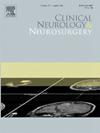Liver fibrosis associated with more severe motor deficits in early Parkinson’s disease
IF 1.8
4区 医学
Q3 CLINICAL NEUROLOGY
引用次数: 0
Abstract
Objective
To determine the impact of hepatic dysfunction on the motor manifestations of Parkinson’s disease.
Methods
We conducted a retrospective cohort study using data from the Parkinson’s Progression Markers Initiative. Liver fibrosis was defined using the Fibrosis-4 score. Our primary outcome was the association of baseline Fibrosis-4 score with the Movement Disorders Society – Unified Parkinson’s Disease Rating Scale (MDS-UPDRS) part III score. Additional outcomes were MDS-UPDRS part II, MDS-UPDRS part IV, Hoehn and Yahr stage, and levodopa equivalent daily dose. We used linear regression models to evaluate associations at baseline and 5 years after enrollment. We used linear mixed models to evaluate the association of liver fibrosis with the progression of motor dysfunction. Models were adjusted for demographics, comorbidities, alcohol use, time since Parkinson’s disease diagnosis, levodopa equivalent daily dose, and genetic predisposition.
Results
We included 360 people with Parkinson’s disease with a mean age of 61.8 years (standard deviation 9.7) and 41.1 % women. There was a significant association between liver fibrosis and baseline MDS-UPDRS part III score (β=2.3, 95 % CI: 0.2, 4.5). Liver fibrosis was also correlated with higher interhemispheric signal asymmetry on DAT-SPECT scans in the anterior putamen (p < 0.05 by Wilcoxon rank sum test). There was no correlation with Fibrosis-4 score and any other motor assessment at baseline or after 5 years. Patients with elevated Fibrosis-4 scores had a slower rate of progression in MDS-UPDRS part III scores.
Conclusion
In people with Parkinson’s disease, the presence of comorbid liver fibrosis was associated with more severe motor dysfunction early, but not later, within their disease course.
肝纤维化与早期帕金森病更严重的运动缺陷相关
目的探讨肝功能障碍对帕金森病运动表现的影响。方法采用帕金森病进展标志物倡议的数据进行回顾性队列研究。肝纤维化的定义采用纤维化-4评分。我们的主要结局是基线纤维化-4评分与运动障碍协会-统一帕金森病评定量表(MDS-UPDRS)第三部分评分的关联。其他结果包括MDS-UPDRS第二部分、MDS-UPDRS第四部分、Hoehn和Yahr分期和左旋多巴当量日剂量。我们使用线性回归模型来评估基线和入组后5年的相关性。我们使用线性混合模型来评估肝纤维化与运动功能障碍进展的关系。根据人口统计学、合并症、酒精使用、帕金森病诊断后的时间、左旋多巴当量日剂量和遗传易感性对模型进行了调整。结果我们纳入了360例帕金森病患者,平均年龄为61.8岁(标准差为9.7),其中41.1% 为女性。肝纤维化与基线MDS-UPDRS第三部分评分有显著相关性(β=2.3, 95 % CI: 0.2, 4.5)。肝纤维化也与前壳核DAT-SPECT扫描的半球间信号不对称性升高相关(Wilcoxon秩和检验p <; 0.05)。与基线或5年后的纤维化-4评分和任何其他运动评估没有相关性。纤维化-4评分升高的患者在MDS-UPDRS第三部分评分中的进展速度较慢。结论在帕金森病患者中,共病性肝纤维化的存在与早期更严重的运动功能障碍相关,而不是后期。
本文章由计算机程序翻译,如有差异,请以英文原文为准。
求助全文
约1分钟内获得全文
求助全文
来源期刊

Clinical Neurology and Neurosurgery
医学-临床神经学
CiteScore
3.70
自引率
5.30%
发文量
358
审稿时长
46 days
期刊介绍:
Clinical Neurology and Neurosurgery is devoted to publishing papers and reports on the clinical aspects of neurology and neurosurgery. It is an international forum for papers of high scientific standard that are of interest to Neurologists and Neurosurgeons world-wide.
 求助内容:
求助内容: 应助结果提醒方式:
应助结果提醒方式:


